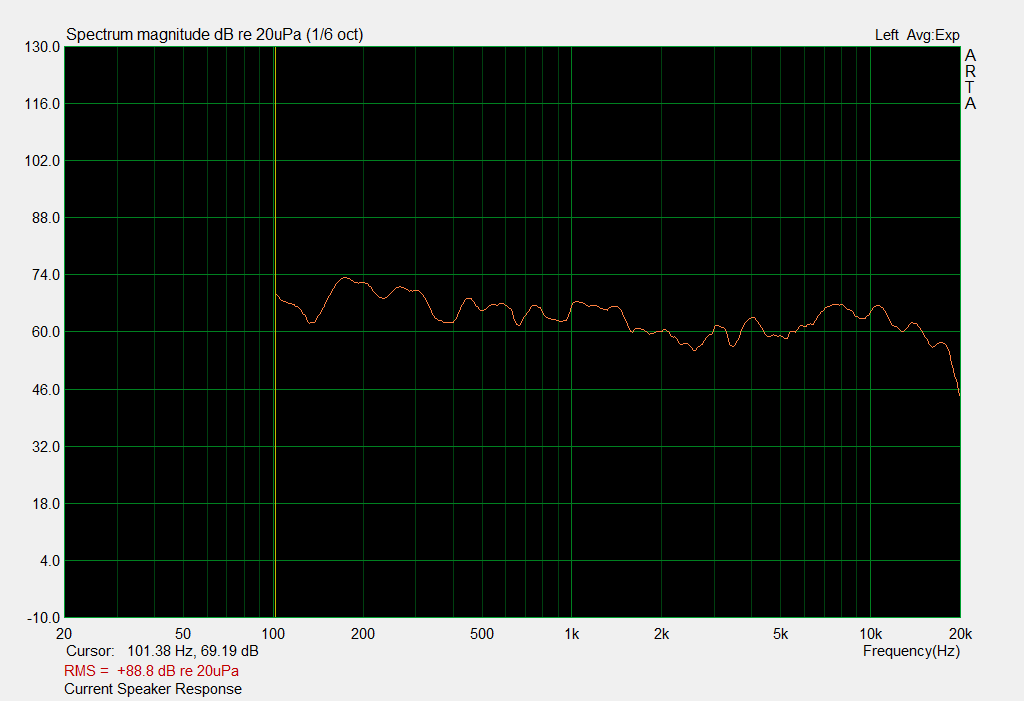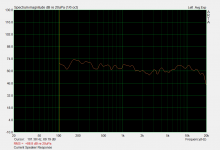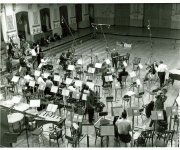Just opposite, we use dsp to equalize speaker treble roll off. The result is more lively and natural then.
One person's glory system can be another's too bright nightmare. It's really a matter of personal taste and also what we are used to hearing. I find a perfectly flat frequency response to sound edgy and bright with all but the highest quality recordings. A very slight attenuation of the highs sounds more natural to me, and many others. To some it may sound to soft but that's fine.
Again, the aim is to match natural sound. Edgy and bright are words that can be applied to the sound of many acoustic instruments in the flesh, and if that is not the best balance for a particular individual then of course that is perfectly fine. However, I find the "edginess and brightness" in many systems to be due to high frequency distortion, rather than the intrinsic sound of the recording - so for best results that should be mitigated ...
I don't find frequency response variations to give rise to 'edginess'. So rather like Frank I reckon if you're getting edginess from flat FR it does rather suggest problems with IMD in the system. Also 'soft' is not for me related to FR, its rather a function of noise modulation - hence DSD sounds 'soft', analog tape sounds 'soft' even though both have flat FR.
Again, the aim is to match natural sound. Edgy and bright are words that can be applied to the sound of many acoustic instruments in the flesh, and if that is not the best balance for a particular individual then of course that is perfectly fine. However, I find the "edginess and brightness" in many systems to be due to high frequency distortion, rather than the intrinsic sound of the recording - so for best results that should be mitigated ...
I'm not talking about edgy and bright of natural instruments, and the recording venue and mic position has a lot to do with that as well. Just because the a flat frequency response might be what was recorded with a mic, doesn't mean that when we set up a stereo system that a perfectly flat frequency response is going to be the most accurate sounding reproduction. There are other educated opinions on this subject, and I'm no expert. I just know what sounds good to me, more like live music. I should really remeasure out current system now that I have a good loudspeaker measuring tool. It is pretty flat I think with a slight boost in the bass and midbass.
Anyway, what sounds most accurate to an audiophile with a given room, given associated components, given sound preference, and so on is going to be different ...
My dad's friend, a tube lover with his low watt amps, doesn't think much of our solid state system. Whatever!
I think I'll take a quick measurement of our stereo and post it here. May be interesting.
John
I have some old recordings on CD that date back to the 50's and 60's (Frank Mobely, Julian Bream, Dave Brubeck and various classical recordings). Funny thing is there's tape hiss, the the freq response is not perfect but they just sound so right.
Then I can put on a really modern recording that's technically immaculate - like Gordon Goodwin for example - and there's no magic there (but they were great when I saw them live).
Then I can put on a really modern recording that's technically immaculate - like Gordon Goodwin for example - and there's no magic there (but they were great when I saw them live).
One has to be careful not to judge the recordings by what the technology of the times did, relatively unintentionally, to "enhance" the sound: Analogue Warmth ...
Been listening to some more of the Decca recordings made using the famous "Decca Tree" microphone arrangement. ( see photo ) I really like this method of recording that records the space as well as the instruments.
If every recording studio in the world used this kind of microphone method I think very detailed amps that use global feedback would probably be a good choice for all domestic playback.
The problem is that many studios prefer the close miking technique that captures only the instrument with no natural accoustic.
Personally I feel this close miking often results in a sound that is a bit too intense & detailed and in these circumstances the slightly more relaxed approach of a zero loop FB amp might be welcome.
So I think I have reached the conclusion that for ideal reproduction of different types of recording we need different types of amplifier - or one amp with a switch, if it could be done without sacrificing quality.
Not easy being an amp designer trying to make the ideal product that is suited all kinds of recording . . . not to mention all kinds of people.
If every recording studio in the world used this kind of microphone method I think very detailed amps that use global feedback would probably be a good choice for all domestic playback.
The problem is that many studios prefer the close miking technique that captures only the instrument with no natural accoustic.
Personally I feel this close miking often results in a sound that is a bit too intense & detailed and in these circumstances the slightly more relaxed approach of a zero loop FB amp might be welcome.
So I think I have reached the conclusion that for ideal reproduction of different types of recording we need different types of amplifier - or one amp with a switch, if it could be done without sacrificing quality.
Not easy being an amp designer trying to make the ideal product that is suited all kinds of recording . . . not to mention all kinds of people.
Attachments
Last edited:
Okay, here is the FR of our system. This at the listening position and I'm sure you all have fun with this but it sounds really good.
I say, this chap has a BBC dip
Of interest, I retrieved the HD version of "Supernatural superserious", a track of that album, from YouTube - to see what I made of it ...Worst album : Accellerate - REM - compressed and lifeless. Really a wall of noise to my ears. I actually threw the CD into the bin - no kidding. What the hell else can you do with something like that?
Fairly typical of of the dense mixes done these days, a good warm up required; need to separate the vocals, the drums with decent reverb, and the currently popular wall of distorted guitar from each other - not a trivial process, but quite achievable. I've got it on repeat at the moment, and it's working quite nicely ...
The intrinsic sound has no problems, but all the musical threads are so closely intertwined that really clean playback is necessary to get these sounds to unravel in their own, discernable, spaces.
Okay, here is the FR of our system. This at the listening position and I'm sure you all have fun with this but it sounds really good. No one in this house hold can hear above 9khz anyway!

Smiley face!
Of interest, I retrieved the HD version of "Supernatural superserious", a track of that album, from YouTube - to see what I made of it ...
Fairly typical of of the dense mixes done these days, a good warm up required; need to separate the vocals, the drums with decent reverb, and the currently popular wall of distorted guitar from each other - not a trivial process, but quite achievable. I've got it on repeat at the moment, and it's working quite nicely ...
The intrinsic sound has no problems, but all the musical threads are so closely intertwined that really clean playback is necessary to get these sounds to unravel in their own, discernable, spaces.
It's crap. Period.
Sorry to be do blunt, but I will just not waste my time on drivel like that.
Last edited:
Well, musically it may be "crap", but I'm always interested as to whether the component sound threads in the mix can be unravelled or not. If the album content is not to one's taste, that's something else - but my curiosity is to whether I can 'see' the structure of the sound, identifying all the individual microphone or whatever feeds. If my system allows me to do that then I can "get" more into the sound, by understanding what they were trying to do.
Haha.It's crap. Period.
Sorry to be do blunt, but I will just not waste my time on drivel like that.
"What's the Frequency, Kenneth?" is useful as a test track.
On a really good system it's sonically pretty impressive actually, even if it is crap music really.
Done right, it's hugely big, with an incredible lack of any dynamics whatsoever in the main passages .....meters hardly move for main parts of the track.
On suboptimal systems this track will hurt your ears immediately.
The thing is, on a good system, everything is nicely separated, the guitar is clean, and it's a fun study in constant level mastering.
'The Dead Kennedys provide useful test tracks also.
The 'Holiday In Cambodia' guitar intro will make your ears bleed on lousy systems, on good systems its presented as matter of fact, distorted guitar panning left and right and fun reverb effects.
I could go on, AC/DC bagpipes are another good test.
I quote rock'n'roll tracks... if the mids/vocals and highs are bearable or fun with these kind of tracks, the system will play just about anything really well, including and importantly vocals and violins.
Dan.
Of interest, I retrieved the HD version of "Supernatural superserious", a track of that album, from YouTube - to see what I made of it ...
Just playing it, no special problem here, yes the voice is distorted, but no problem to separate instruments, voices etc., and it is listenable.
For similar purposes, like testing ability to distinct individual sounds from the ball of sound, I use Rolling Stones track 'Flip the Switch' (Bridges to Babylon).
Telarc did a mike set some what like that when recording in Cincinnati. As a side note while setting up the audience mike by chance I tipped on one of the mike cord that was coiled up . The engineer ask what I did . I told him . He said it sounded better. to which I replied how do you make an inductor coil up wirer. Most interesting that these professional recording engineers knew so little of basic electronics.Been listening to some more of the Decca recordings made using the famous "Decca Tree" microphone arrangement. ( see photo ) I really like this method of recording that records the space as well as the instruments.
If every recording studio in the world used this kind of microphone method I think very detailed amps that use global feedback would probably be a good choice for all domestic playback.
The problem is that many studios prefer the close miking technique that captures only the instrument with no natural accoustic.
Personally I feel this close miking often results in a sound that is a bit too intense & detailed and in these circumstances the slightly more relaxed approach of a zero loop FB amp might be welcome.
So I think I have reached the conclusion that for ideal reproduction of different types of recording we need different types of amplifier - or one amp with a switch, if it could be done without sacrificing quality.
Not easy being an amp designer trying to make the ideal product that is suited all kinds of recording . . . not to mention all kinds of people.
Telarc did a mike set some what like that when recording in Cincinnati. As a side note while setting up the audience mike by chance I tipped on one of the mike cord that was coiled up . The engineer ask what I did . I told him . He said it sounded better. to which I replied how do you make an inductor coil up wirer. Most interesting that these professional recording engineers knew so little of basic electronics.
Coiling up a twisted pair mike cable does not increase inductance.
jn
- Status
- Not open for further replies.
- Home
- Member Areas
- The Lounge
- John Curl's Blowtorch preamplifier part II

